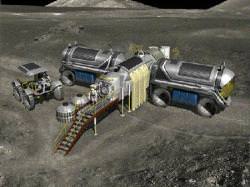Based on what we currently know about the makeup of the lunar regolith, future colonists on the moon will not be able to use the soil on hand to grow food. But in a new experiment, bacteria called cyanobacteria grew quite well in simulated lunar soil. While this wouldn't be a food source for humans, it would enable lunar soil to be broken down to extract resources for making rocket fuel and fertilizer for crops. This could help with the feasibility of setting up a base on the moon, aiding in reducing costs for certain supplies.
Lunar soil isn't conducive for growing plants from Earth because many of the nutrients in the soil are locked up in tough minerals that the plants cannot break down. But a group led by Igor Brown of NASA's Johnson Space Center added the cyanobacteria taken from hot springs in Yellowstone National Park in Wyoming (US), to materials designed to approximate the lunar soil. They found that when water, air and light were supplied, the cyanobacteria grew quite well. Cyanobacteria were found to produce acids that work very well to break down tough minerals, including ilmenite, which is relatively abundant on the moon.
Breaking down the same minerals artificially would require heating them to very high temperatures, which would use precious energy, Brown said. Cyanobacteria, on the other hand, use only sunlight for energy, although they do their extraction work more slowly than heating the soil artificially.
Cyanobacteria typically grow in water-rich environments. They are technically a type of bacteria, but like plants, they produce their own food via photosynthesis.
Brown says he envisions growth chambers for cyanobacteria being set up on the Moon, as part of a multi-step process for making use of the resources bound in the lunar soil. The chambers would be supplied with water, sunlight and lunar soil to allow the cyanobacteria to grow.
Cyanobacteria harvested from the chambers could then be further processed to make use of the elements they extract from the lunar soil. For example, they could be broken down by other bacteria, resulting in a nutrient-rich soup that could be used as fertilizer for food plants grown in hydroponic greenhouses. Methane given off by the breakdown of the cyanobacteria could be used as rocket fuel.
Original News Source:
New Scientist
 Universe Today
Universe Today
